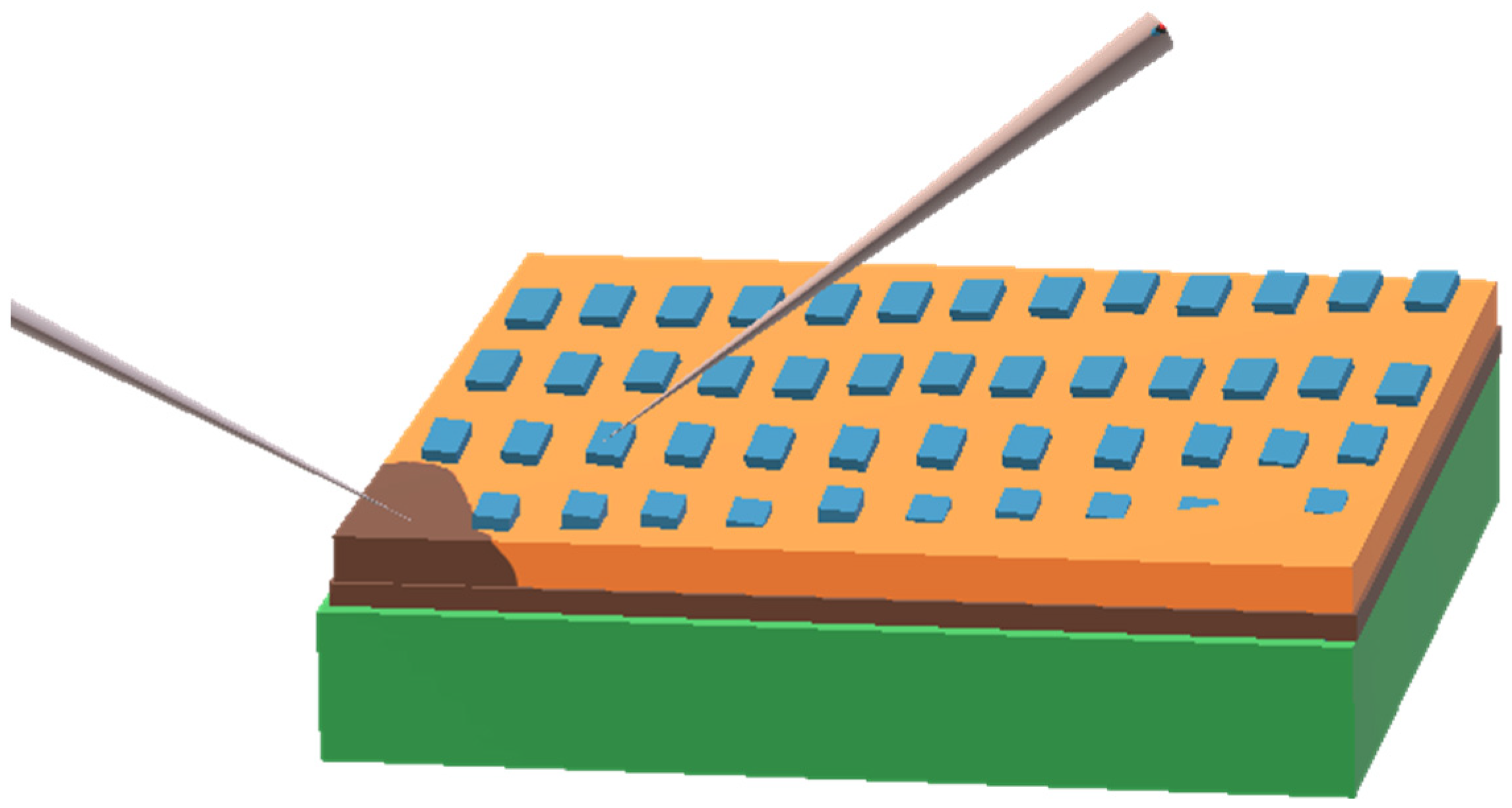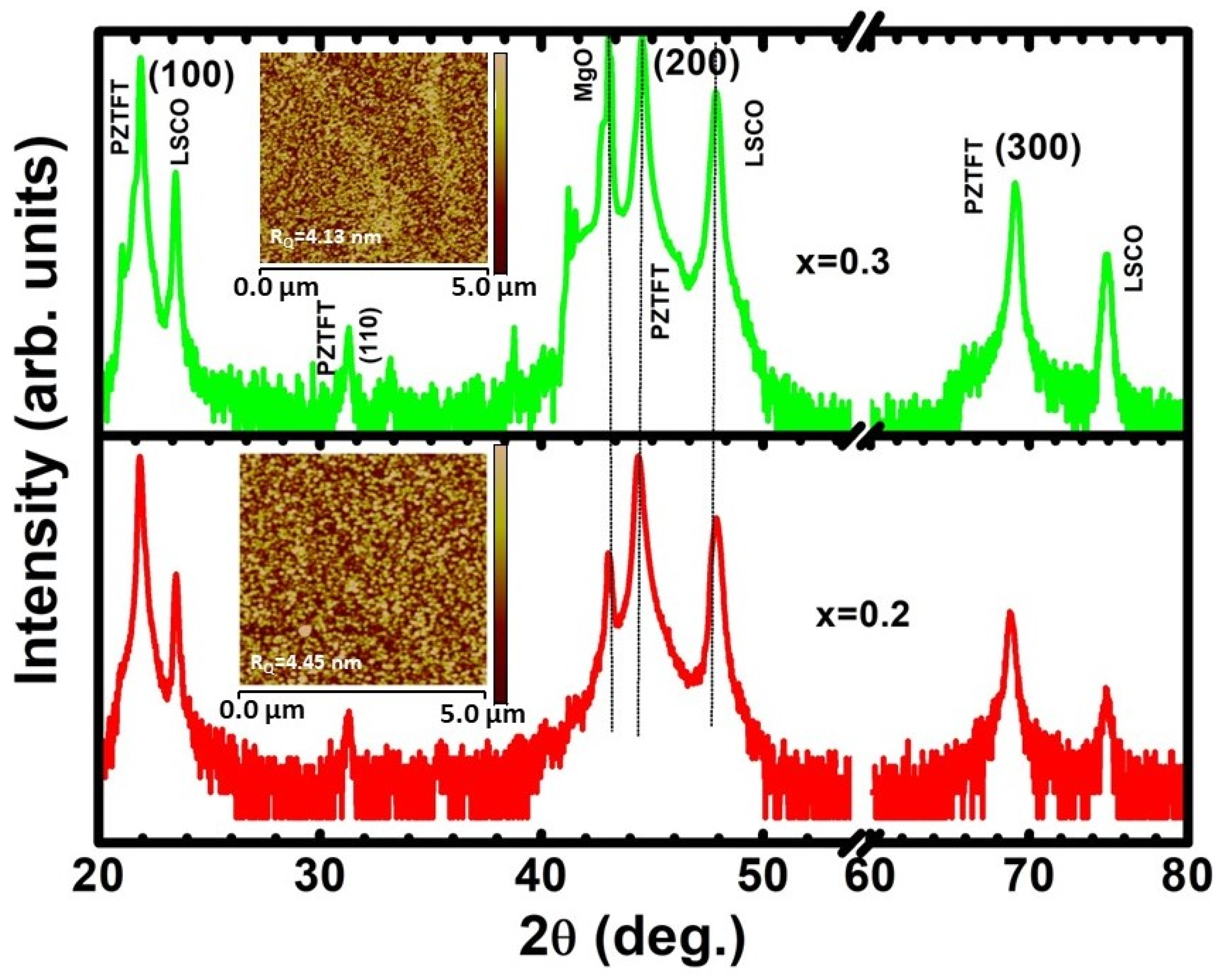Room-Temperature, Nanoscale Multiferroic Pb(Fe0.5Ta0.5)1−x(Zr0.53Ti0.47)xO3 (x = 0.2, 0.3) Thin Films Grown via the Pulsed Laser Deposition Technique
Abstract
:1. Introduction
2. Materials and Methods
3. Results and Discussion
4. Conclusions
Author Contributions
Funding
Institutional Review Board Statement
Informed Consent Statement
Data Availability Statement
Conflicts of Interest
References
- Kimura, T.; Goto, T.; Shintani, H.; Ishizaka, K.; Arima, T.; Tokura, Y. Magnetic control of ferroelectric polarization. Nature 2003, 426, 55–58. [Google Scholar] [CrossRef]
- Eerenstein, W.; Mathur, N.D.; Scott, J.F. Multiferroic and magnetoelectric materials. Nature 2006, 422, 759–765. [Google Scholar] [CrossRef] [PubMed]
- Tokura, Y.; Seki, S.; Nagaosa, N. Multiferroics of spin origin. Rep. Prog. Phys. 2014, 77, 076501. [Google Scholar] [CrossRef] [PubMed]
- Ohno, H.; Chiba, D.; Matsukura, F.; Omiya, T.; Abe, E.; Dietl, T.; Ohno, Y.; Ohtani, K. Electric-field control of ferromagnetism. Nature 2000, 408, 944–946. [Google Scholar] [CrossRef] [PubMed]
- Prellier, W.; Singh, M.P.; Murugavel, P. The single-phase multiferroic oxides: From bulk to thin film. J. Phys. Condens. Matter. 2005, 17, R803. [Google Scholar] [CrossRef]
- Hill, N.A. Why Are There So Few Magnetic Ferroelectrics? J. Phys. Chem. B 2000, 104, 6694–6709. [Google Scholar] [CrossRef]
- Wang, J.; Neaton, J.B.; Zheng, H.; Nagarajan, V.; Ogale, S.B.; Liu, B.; Viehland, D.; Vaithyanathan, V.; Schlom, D.G.; Waghmare, U.V.; et al. Epitaxial BiFeO3 Multiferroic Thin Film Heterostructures. Science 2003, 299, 1719–1722. [Google Scholar] [CrossRef]
- Song, S.; Jang, H.M.; Lee, N.-S.; Son, J.Y.; Gupta, R.; Garg, A.; Ratanapreechachai, J.; Scott, J.F. Ferroelectric polarization switching with a remarkably high activation energy in orthorhombic GaFeO3 thin films. NPG Asia Mater. 2016, 8, e242. [Google Scholar] [CrossRef]
- Mishra, K.K.; Hernandez, J.A.; Instan, A.A.; McCartan, S.J.; Gregg, M.; Katiyar, R.S. Lead palladium zirconate titanate: A room temperature nanoscale multiferroic thin film. J. Appl. Phys. 2020, 127, 204104. [Google Scholar] [CrossRef]
- Kumari, S.; Pradhan, D.K.; Ortega, N.; Pradhan, K.; DeVreugd, C.; Srinivasan, G.; Kumar, A.; Paudel, T.R.; Tsymbal, E.Y.; Bumstead, A.M.; et al. Palladium-based ferroelectrics and multiferroics: Theory and experiment. Phys. Rev. B 2017, 95, 214109. [Google Scholar] [CrossRef]
- Evans, D.M.; Schilling, A.; Kumar, A.; Sanchez, D.; Ortega, N.; Arredondo, M.; Katiyar, R.S.; Gregg, J.M.; Scott, J.F. Magnetic switching of ferroelectric domains at room temperature in multiferroic PZTFT. Nat. Commun. 2013, 4, 1534. [Google Scholar] [CrossRef] [PubMed]
- Sanchez, D.; Ortega, N.; Kumar, A.S.; Roque-Malherbe, R.M.A.; Polanco, R.; Scott, J.F.; Katiyar, R.S. Symmetries and multiferroic properties of novel room-temperature magnetoelectrics: Lead iron tantalate-lead zirconate titanate (PFT/PZT). AIP Adv. 2011, 1, 042169. [Google Scholar] [CrossRef]
- Gonnard, P.; Troccaz, M. Dopant distribution between A and B sites in the PZT ceramics of type ABO3. J. Solid State Chem. 1978, 23, 321–326. [Google Scholar] [CrossRef]
- Fernandes, J.R.A.; Joanni, E.; Savu, R. Optimization of the Fabrication Parameters of PZT 52/48 Thin Films by Pulsed Laser Ablation. Mater. Sci. Forum 2006, 514–516, 1353–1357. [Google Scholar] [CrossRef]
- Jaffe, B.; Roth, R.S.; Marzullo, S. Piezoelectric properties of lead zirconate-leadtitanate solid-solution ceramics. J. Appl. Phys. 1954, 25, 809–810. [Google Scholar] [CrossRef]
- Noheda, B.; Gonzalo, J.A.; Cross, L.E.; Gou, R.; Park, S.-E.; Cox, D.E.; Shirane, G. Tetragonal-to-monoclinic phase transition in a ferroelectric perovskite: The structure of PbZr0.52Ti0.48O3. Phys. Rev. B 2000, 61, 8687. [Google Scholar] [CrossRef]
- Levstik, A.; Bobnar, V.; Filipic, C.; Holc, J.; Kosec, M.; Blinc, R.; Trontel, Z.; Jaglicic, Z. Magnetoelectric relaxor. Appl. Phys. Lett. 2007, 91, 012905. [Google Scholar] [CrossRef]
- Sanchez, D.A.; Kumar, A.; Ortega, N.; Katiyar, R.S.; Scott, J.F. Near-room temperature relaxor multiferroic. Appl. Phys. Lett. 2010, 97, 202910. [Google Scholar] [CrossRef]
- Wu, Y.-C.; Ho, S.Z.; Liu, Y.C.; Liou, Y.-D.; Liu, W.-Y.; Huang, S.-W.; Jiang, J.; Chen, Y.-C.; Yang, J.-C. Room Temperature Multiferroic PZTFT Thin Films. ACS Appl. Electron. Mater. 2020, 2, 19–24. [Google Scholar] [CrossRef]
- Sanchez, D.A.; Ortega, N.; Kumar, A.; Sreenivasulu, G.; Katiyar, R.S.; Scott, J.F.; Evans, D.M.; Arredondo-Arechavala, M.; Schilling, A.; Gregg, J.M. Room-temperature single phase multiferroic magnetoelectric: Pb(Fe, M)x(Zr,Ti)(1−x)O3[M = Ta, Nb]. J. Appl. Phys. 2013, 113, 074105. [Google Scholar] [CrossRef]
- Eerenstein, W.; Morrison, F.D.; Dho, J.; Blamire, M.G.; Scott, J.F.; Mathur, N.D. Comment on Epitaxial BiFeO3 multiferroic thin film heterostructures. Science 2005, 307, 1203. [Google Scholar] [CrossRef] [PubMed]
- Fiebig, M. Revival of the Magnetoelectric Effect. J. Phys. D Appl. Phys. 2005, 38, R123. [Google Scholar] [CrossRef]
- Goto, T.; Kim, D.H.; Sun, X.; Onbasli, M.C.; Florez, J.M.; Ong, S.P.; Vargas, P.; Ackland, K.; Stamenov, P.; Aimon, N.M.; et al. Magnetism and Faraday Rotation in Oxygen-Deficient Polycrystalline and Single-Crystal Iron-Substituted Strontium Titanate. Phys. Rev. Appl. 2017, 7, 024006. [Google Scholar] [CrossRef]
- Florez, J.M.; Solis, M.A.; Corte, E.A.; Morell, E.S.; Ross, C.A. First-principles based Monte Carlo modeling of the magnetization of oxygen-deficient Fe-substituted SrTiO3. Phys. Chem. Chem. Phys. 2023, 25, 19214. [Google Scholar] [CrossRef]
- Bajpai, P.K.; Pastor, M.; Singh, K.N. Diffuse Phase Transition and Electrical Conductivity of Pb(Ca1/3Nb2/3)O3. J. Electron. Mater. 2014, 43, 1403–1410. [Google Scholar] [CrossRef]
- Boukamp, B.A.; Pham, M.T.N.; Blank, D.H.A.; Bouwmeester, H.J.M. Inonic and electronic conductivity in lead-zirconate-titanate (PZT). Solid State Ionics. 2004, 170, 239. [Google Scholar] [CrossRef]
- Kleemann, W.; Shvartsman, V.; Borisov, P.; Kania, A. Coexistence of Antiferromagnetic and Spin Cluster Glass in the Magnetoelectric Relaxor Multiferroic PbFe0.5Nb0.5O3. Phys. Rev. Lett. 2010, 105, 257202–257204. [Google Scholar] [CrossRef] [PubMed]
- Pradhan, D.K.; Kumari, S.; Vasudevan, R.K.; Strelcov, E.; Puli, V.S.; Pradhan, D.K.; Kumar, A.; Gregg, J.M.; Pradhan, A.K.; Kalinin, S.V.; et al. Exploring the Magnetoelectric Coupling at the Composite Interfaces of FE/FM/FE Heterostructures. Sci. Rep. 2018, 8, 17381. [Google Scholar] [CrossRef]
- Yu, Z.; Guo, R.; Bhalla, A.S. Dielectric behavior of Ba(Ti1−xZrx)O3 single crystals. J. Appl. Phys. 2000, 88, 410–415. [Google Scholar] [CrossRef]
- Moquim, A.; Panigrahi, M.R. Phase transition and relaxor nature of (Ba0.77Ca0.23)(Ti0.98La0.02)O3 ceramic prepared by mixed oxide route. J. Mater. Sci. Mater. Electron. 2015, 26, 4956–4962. [Google Scholar] [CrossRef]
- M’Peko, J.C.; Peixoto, A.G.; Jimenez, E.; Gaggero-Sager, L.M. Electrical Properties of Nb-Doped PZT 65/35 Ceramics: Influence of Nb and Excess PbO. J. Electroceram. 2005, 15, 167–176. [Google Scholar] [CrossRef]
- Zhang, T.-F.; Huang, X.-X.; Tang, X.-G.; Jiang, Y.-P.; Liu, Q.-X.; Lu, B.; Lu, S.-G. Enhanced electrocaloric analysis and energy-storage performance of lanthanum modified lead titanate ceramics for potential solid-state refrigeration applications. Sci. Rep. 2018, 8, 396. [Google Scholar] [CrossRef]
- Diez-betriu, X.; Garcia, J.E.; Ostos, C.; Boya, A.U.; Ochoa, D.A.; Mestres, L.; Perez, R. Phase transition characteristics and dielectric properties of rare-earth (La, Pr, Nd, Gd) doped Ba(Zr0.09Ti0.91)O3 ceramics. Mater. Chem. Phys. 2011, 125, 493–499. [Google Scholar] [CrossRef]
- Tomas, R.; Mochizuki, S.; Mihara, T.; Ishida, T. Perovskite crystallization of sol-gel processed (Pb, La0.06, Gd0.02)(Zr0.65,Ti0.35)O3 thin films: Dielectric, ferroelectric and optical properties. J. Mater. Res. 2002, 17, 2652–2659. [Google Scholar] [CrossRef]
- Lee, J.; Ramesh, R. Imprint of (Pb,La)(Zr,Ti)O3 thin films with various crystalline qualities. Appl. Phys. Lett. 1996, 68, 484–486. [Google Scholar] [CrossRef]
- Bolten, D.; Lohse, O.; Grossmann, M.; Waser, R. Reversible and irreversible domain wall contributions to the polarization in ferroelectric thin films. Ferroelectrics 1999, 221, 251–257. [Google Scholar] [CrossRef]
- Sharma, Y.; Barrionuevo, D.; Agarwal, R.; Pavunny, S.P.; Katiyar, R.S. Ferroelectricity in Rare-Earth Modified Hafnia Thin Films Deposited by Sequential Pulsed Laser Deposition. ECS Solid State Lett. 2015, 4, N13–N16. [Google Scholar] [CrossRef]
- Liu, W.-Y.; Liao, J.-J.; Jiang, J.; Zhou, Y.-C.; Chen, Q.; Mo, S.-T.; Yang, Q.; Peng, Q.-X.; Jiang, L.-M. Highly stable performance of flexible Hf0.6Zr0.4O2 ferroelectric thin films under multi-service conditions. J. Mater. Chem. C 2020, 8, 3878. [Google Scholar] [CrossRef]
- Hu, W.J.; Juo, D.-M.; You, L.; Wang, J.; Chen, Y.-C.; Chu, Y.-H.; Wu, T. Universal Ferroelectric Switching Dynamics of Vinylidene Fluoride-trifluoroethylene Copolymer Film. Sci. Rep. 2014, 4, 4772. [Google Scholar] [CrossRef]
- Wang, Y.; Hu, J.; Lin, Y.; Nan, C.-W. Multiferroic Magnetoelectric Composite Nanostructures. NPG Asia Mater. 2014, 4, 4772. [Google Scholar] [CrossRef]
- Ma, J.; Hu, J.; Li, Z.; Nan, C.-W. Recent Progress in Multiferroic Magnetoelectric Composites: From Bulk to Thin Films. Adv. Mater. 2011, 23, 1062–1087. [Google Scholar] [CrossRef] [PubMed]
- Hu, J.-M.; Nan, C.-W.; Chen, L.-Q. Size-dependent electric voltage controlled magnetic anisotropy in multiferroic heterostructures: Interface-charge and strain co-mediated magnetoelectric coupling. Phys. Rev. B 2011, 83, 134408. [Google Scholar] [CrossRef]
- Gupta, R.; Chaudhary, S.; Kotnala, R.K. Interfacial Charge Induced Magnetoelectric Coupling at BiFeO3/BaTiO3 Bilayer Interface. ACS Appl. Mater. Interfaces 2015, 7, 8472–8479. [Google Scholar] [CrossRef] [PubMed]
- Kulikowski, J.; Bienkowski, A. Magnetostrictive properties of Cox(NiZn)1−xFe2O4 ferrites in the case of small changes of iron content. J. Magn. Magn. Mater. 1984, 41, 63. [Google Scholar] [CrossRef]
- Fang, F.; Xu, Y.T.; Yang, W. Magnetoelectric coupling of laminated composites under combined thermal and magnetic loadings. J. Appl. Phys. 2012, 111, 023906. [Google Scholar] [CrossRef]
- Gupta, R.; Shah, J.; Chaudhary, S.; Kotnala, R.K. Magnetoelectric dipole interaction in RF-magnetron sputtered (1−x)BiFeO3-xBaTiO3 thin films. J. Alloys Compd. 2015, 638, 115–120. [Google Scholar] [CrossRef]






| Substrate | MgO |
|---|---|
| Target | Pb(Fe0.5Ta0.5)x(Zr0.53Ti0.47)1−x |
| Target diameter | 0.025 m |
| Substrate target distance | 0.05 m |
| Growth temperature | 873 K |
| Base vacuum | ~10−6 Torr |
| O2 partial pressure | 300 mTorr |
| Laser | Excimer (λ = 248 nm, KrF) |
| Laser energy | 250 mJ |
| Pulse repetition rate | 10 Hz |
| Plume energy density | 1.5 J/cm2 |
| Thin-film annealing (post deposition) | 873 K at 300 Torr of O2 |
| Composition x | εm | Tm (K) | C (×105 K) | Tcw (K) | ΔTm (K) | γ |
|---|---|---|---|---|---|---|
| 0.2 | 1650 | 560 | 1.96 | 590 | 30 | 1.93 |
| 0.3 | 1616 | 520 | 1.36 | 560 | 40 | 1.95 |
Disclaimer/Publisher’s Note: The statements, opinions and data contained in all publications are solely those of the individual author(s) and contributor(s) and not of MDPI and/or the editor(s). MDPI and/or the editor(s) disclaim responsibility for any injury to people or property resulting from any ideas, methods, instructions or products referred to in the content. |
© 2023 by the authors. Licensee MDPI, Basel, Switzerland. This article is an open access article distributed under the terms and conditions of the Creative Commons Attribution (CC BY) license (https://creativecommons.org/licenses/by/4.0/).
Share and Cite
Sanchez, D.A.; Mishra, K.K.; Saha, S.; Srinivasan, G.; Katiyar, R.S. Room-Temperature, Nanoscale Multiferroic Pb(Fe0.5Ta0.5)1−x(Zr0.53Ti0.47)xO3 (x = 0.2, 0.3) Thin Films Grown via the Pulsed Laser Deposition Technique. Crystals 2023, 13, 1442. https://doi.org/10.3390/cryst13101442
Sanchez DA, Mishra KK, Saha S, Srinivasan G, Katiyar RS. Room-Temperature, Nanoscale Multiferroic Pb(Fe0.5Ta0.5)1−x(Zr0.53Ti0.47)xO3 (x = 0.2, 0.3) Thin Films Grown via the Pulsed Laser Deposition Technique. Crystals. 2023; 13(10):1442. https://doi.org/10.3390/cryst13101442
Chicago/Turabian StyleSanchez, Dilsom A., Karuna Kara Mishra, Sujoy Saha, Gopalan Srinivasan, and Ram S. Katiyar. 2023. "Room-Temperature, Nanoscale Multiferroic Pb(Fe0.5Ta0.5)1−x(Zr0.53Ti0.47)xO3 (x = 0.2, 0.3) Thin Films Grown via the Pulsed Laser Deposition Technique" Crystals 13, no. 10: 1442. https://doi.org/10.3390/cryst13101442
APA StyleSanchez, D. A., Mishra, K. K., Saha, S., Srinivasan, G., & Katiyar, R. S. (2023). Room-Temperature, Nanoscale Multiferroic Pb(Fe0.5Ta0.5)1−x(Zr0.53Ti0.47)xO3 (x = 0.2, 0.3) Thin Films Grown via the Pulsed Laser Deposition Technique. Crystals, 13(10), 1442. https://doi.org/10.3390/cryst13101442








